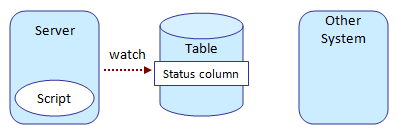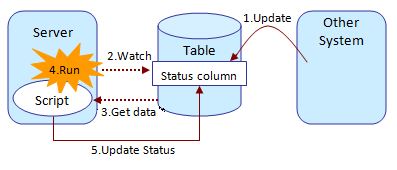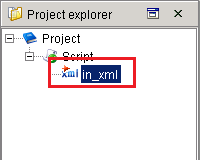| Item name |
Content |
Remarks |
| Trigger name |
Enter the name of the trigger. |
|
| Connection |
Select Global Resources. |
 Refer to here for available global resources. Refer to here for available global resources.
|
| Watch table |
Select or enter the table to be monitored. |
 The maximum number of tables listed is determined by Global Resource settings. The maximum number of tables listed is determined by Global Resource settings. Variables such as environment variables cannot be used. Variables such as environment variables cannot be used.
|
| Status column |
Select or enter the status column to be monitored. |
 Variables such as Environment Variables cannot be used. Variables such as Environment Variables cannot be used.
|
| Watch event |
Select or enter the status column to be monitored.
- [Insert]: (default)
Fires when the value of the status column is [Waiting trigger when inserted].
- [Update]:
Fires when the value of the status column is [Waiting trigger when updated].
- [Delete]:
Fires when the value of the status column is [Waiting trigger when deleted].
|
- Multiple items can be selected.
|
| Watch interval |
Enter the monitoring interval in seconds. |
- The default value is "10".
|
| End option |
Select the option at the end of the script.
- [Change status only when succeeded]: (default)
Only when the execution of the script succeeded, change value of all status columns back to [Unmodified] or [Deleted].
- [Change status regardless of success/failure]:
Regardless whether the execution of the script succeeded, change value of all status columns back to [Unmodified] or [Deleted].
|
|
| Store sending data to script in memory |
Select whether to hold data retrieved when the trigger fired in the memory.
- [Checked]: (default)
Holds data retrieved when the trigger fired in the memory.
- [Not Checked]:
Hold data retrieved when the trigger fired in the file.
|
Select [Not Checked] when the data is large volume. |
| Status values |
Enter a value for each state.
| Value | Status |
| 0 (default) | Unmodified |
| 1 (default) | Waiting trigger when inserted |
| 2 (default) | Waiting trigger when updated |
| 3 (default) | Waiting trigger when deleted |
| 4 (default) | Deleted |
|
- [Value] can be edited.
 Specify [Value] as integer "0" to under "100", or "11000" and higher.(The maximum value depends on the type of the status column.) Specify [Value] as integer "0" to under "100", or "11000" and higher.(The maximum value depends on the type of the status column.)
The range can also be changed.
 Refer to "Execution ID"for more information. Refer to "Execution ID"for more information. [Value] cannot be specified with duplicate values. [Value] cannot be specified with duplicate values.- [Status] can not be edited.
|
| Item name |
Content |
Remarks |
| Trigger owner |
Select the owner of the trigger to be created. |
 Can only be selected by users with administrator privileges. Can only be selected by users with administrator privileges.
(Ordinary users can select themselves only.)
|
| Execution user name |
Select the user to run script specified by [Script]. |
|
| Password |
Type the password associated with the user specified by [Execution user name]. |
|
| Service |
Select the script to run by trigger. |
- Project that was registered as a service displays.
|
| Script |
Select the script to run by trigger. |
- Script in the service specified by [Service] displays.
|
| Script arguments |
script input variables that is set in script specified by [Script] displays |
- The script output variable does not display.
 It is necessary that Script input variable of XML type is set at execution script. Also XML type script input variable should be placed at the highest position. It is necessary that Script input variable of XML type is set at execution script. Also XML type script input variable should be placed at the highest position. Refer to "Input variable / Output variable" for how to set script output variable on script and use it. Refer to "Input variable / Output variable" for how to set script output variable on script and use it. |
| Script arguments / Variable name |
Script variable name is displayed. |
|
| Script arguments / Type |
Script variable number type is displayed. |
|
| Script arguments / Value |
Enter a script variable value. |
|


 To execute DB trigger, you must prepare a column to specify status value in the monitoring table.
To execute DB trigger, you must prepare a column to specify status value in the monitoring table.
 Refer to here for more information about pre-settings.
Refer to here for more information about pre-settings.


 For more information about Setting execution option, refer to "Execution option settings".
For more information about Setting execution option, refer to "Execution option settings".

 The status column date type need to be integer (INTEGER).Data size need to be "5" or more.
The status column date type need to be integer (INTEGER).Data size need to be "5" or more.
 About Script variables, refer to "Script variable".
About Script variables, refer to "Script variable".

 XML data passed from the trigger will be assigned to the script input variable at the top of the script, so please put the XML type script variable on the top of the list.
XML data passed from the trigger will be assigned to the script input variable at the top of the script, so please put the XML type script variable on the top of the list.
 If the monitored table's structure has been changed, repeat the above procedure to update Mapper schema.
If the monitored table's structure has been changed, repeat the above procedure to update Mapper schema.
 The type of quotation marks suitable varies depending on databases. For more details, please contact database vendors.
The type of quotation marks suitable varies depending on databases. For more details, please contact database vendors.